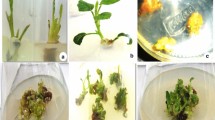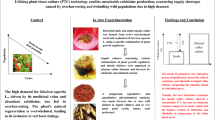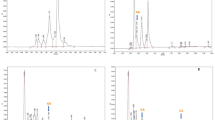Abstract
Opuntia streptacantha and Opuntia megacantha are considered wild species, while Opuntia ficus-indica is deemed a domesticated species. Opuntia species have relevant nutritional and medicinal properties, related to their high levels of phenolics compounds. The objective of this study was to establish callus and cell suspensions of O. streptacantha (cv. Tuna loca), O. megacantha (cv. Rubi reina), and O. ficus-indica (cv. Rojo vigor), and to compare their potential as a source of metabolite production in vitro. Opuntia seeds were physically and chemically scarified obtaining 70–100 % germination. Fast-growing callus and cell suspensions were generated on Murashige and Skoog media supplemented with different concentrations of 2,4-D (0.5, 1.0 mg L−1), and BAP (1.5, 2.0 mg L−1) applied alone or in combination. In general, media containing both, 2,4-D and BAP were more efficient in inducing callus formation than 2,4-D or BAP alone. The content of phenolic acids and flavonoids, and antioxidant activity were all similar in callus and suspensions; however, growth rate was higher in cell suspensions in all species. Production of phenolic acids was correlated to the antioxidant activity, with these parameters being higher in O. streptacantha, the wild species. The concentration of metabolites in callus and cellular suspensions was about three times higher compared with cladodes, indicating that the use of in vitro cultures of Opuntia species is a viable alternative for the production of antioxidants under controlled conditions.





Similar content being viewed by others
References
Ahmad A, Davies J, Randall S, Skinner GR (1996) Antiviral properties of extract of Opuntia streptacantha. Antiviral Res 30:75–85
Ahmed MS, El-Tanbouly ND, Islam WT, Sleem AA, El-Senousy AS (2005) Antiinflammatory flavonoids from Opuntia dilleni Ker-Gawl Haw flowers growing in Egypt. Phytother Res 19:807–809
Aires V, Adote S, Hichami A (2004) Modulation of intracellular calcium concentrations and T cell activation by prickly pear polyphenols. Mol Cell Biochem 260:103–110
Anaya-Pérez MA (2006) History of the use of Opuntia as forage in México. In: Cactus (Opuntia spp.) as forage. FAO Plant Production and Protection Paper 169. http://www.fao.org/WAICENT/FAOINFO/AGRICULT/AGP/AGPC/doc/pasture/CACTUS.HTM
Andrade-Cetto A, Wiedenfeld H (2011) Anti-hyperglycemic effect of Opuntia streptacantha Lem. J Ethnopharmacol 133:940–943
Astello-García MG, Barba-de la Rosa P, Santos-Díaz MS (2013) Establishment of callus from non-domesticated species Opuntia robusta Wendl. and phenolics compounds production. Afr J Biotechnol 12:3204–3207
Astello-García MG, Cervantes I, Nair V, Reyes-Agüero A, Santos-Díaz MS, Guéraud F, Negre-Salvayre A, Rossignol M, Cisneros-Zevallos L, Barba-de la Rosa AP (2015) Chemical composition and phenolic compounds profile of Opuntia ssp. cultivars with different domestication grade. J Food Compos Anal 43:119–130
Bwititi P, Musabayane CT, Nhachi CFB (2000) Effects of Opuntia megacantha on blood glucose and kidney function in streptozotocin diabetic rats. J Ethnopharmacol 69:247–252
De Oliveira AJB, Gonçalves RAC (2006) Alkaloid production and isozymes expression from cell suspension culture of Cereus peruvianus (Cactaceae). J Plant Sci 1:324–331
Escobar HA, Villalobos AVM, Villegas MA (1986) Opuntia micropropagation by axillary proliferation. Plant Cell Tissue Org Cult 7:269–277
Flores CA (1995) Cactus pear and nopalito production in Mexico. Proc JPACD 1:27–44
Galati EM, Mondello R, Giuffrida D, Dugo G, Miceli N, Pergolizzi S, Taviano MF (2003) Chemical characterization and biological effects of Sicilian Opuntia ficus indica (L). Mill. fruit juice: antioxidant and antiulcerogenic activity. J Agric Food Chem 51:4903–4908
García-Saucedo PA, Valdéz-Morales M, Valverde ME, Cruz-Hernández A, Paredes-López O (2005) Plant regeneration of three Opuntia genotypes used as human food. Plant Cell Tissue Org Cult 80:215–219
Gillaspy GE (2011) The cellular language of myo-inositol signaling. New Phytol 192:823–839
Keller J, Camaré C, Bernis C, Astello-García M, de la Rosa APB, Rossignol M, Santos-Díaz MS, Salvayre R, Negre-Salvayre A, Guéraud F (2015) Antiatherogenic and antitumoral properties of Opuntia cladodes: inhibition of low density lipoprotein oxidation by vascular cells, and protection against the cytotoxicity of lipid oxidation product 4-hydroxynonenal in a colorectal cancer cellular model. J Physiol Biochem. doi:10.1007/s13105-015-0408-x
Kim JH, Park SM, Ha HJ (2006) Opuntia ficus-indica attenuates neuronal injury in in vitro and in vivo models of cerebral ischemia. J Ethnopharmacol 104:257–262
Li CY, Cheng XS, Cui MZ (2005) Regulative effect of Opuntia powder on blood lipids in rats and its mechanism. Zhongguo Zhong Yao Za Zhi 30:694–696
Llamoca-Zárate RM, Campos RAP, Landsman J (1999) Establishment and transformation of callus and cell suspension cultures of the prickly-pear (Opuntia ficus indica). JPACD 3:27–33
Lucchesini M, Mensuali-Sodi A (2010) Plant tissue culture—an opportunity for the production of nutraceuticals. In: Giardi MT, Rea G, Berra B (eds) Bio-farms for nutraceuticals. Springer, Berlin, pp 185–202
Mandujano MC, Montaña C, Rojas-Arechiga M (2005) Breaking seed dormancy in Opuntia rastrera from the Chihuahuan desert. J Arid Environ 62:15–21
Mohamed-Yasseen Y, Barringer S, Splittstoesser WE (1996) A note on uses of Opuntia spp. in Central/North America. J Arid Environ 32:347–353
Mohamed-Yassen Y, Barringer S, Splittsoesser WE, Schnell RJ (1995) Rapid propagation of tuna (Opuntia ficus-indica) and establishment in soil. Plant Cell Tissue Org Cult 42:117–119
Mulabagal V, Hsin-Sheng T (2004) Plant cell cultures: an alternative and efficient source for the production of biologically important secondary metabolites. Int J Appl Sci Eng 1:29–48
Murashige T, Skoog F (1962) A revised medium for rapid growth and bio assays with tobacco tissue cultures. Physiol Plant 15:473–497
Orozco-Segovia A, Márquez-Gúzman J, Sánchez-Coronado ME, Gamboa de Buen A, Baskin JM, Baskin CC (2007) Seed anatomy and water uptake in relation to seed dormancy in Opuntia tomentosa (Cactaceae, Opuntioideae). Ann Bot 99:581–592
Piga A (2004) Cactus pear: a fruit of nutraceutical and functional importance. JPACA 6:9–22
Russel C, Felker P (1987) The prickly pear (Opuntia spp. Cactaceae): a source of human and animal food in semiarid regions. Econ Bot 41:433–445
Saleem M, Kim HJ, Han CK, Jin C, Lee YS (2006) Secondary metabolites from Opuntia ficus.indica var. Saboten. J Phytochem 67:1390–1394
Santos Díaz MS, Velásquez García Y, González Chávez MM (2005) Producción de pigmentos por callos de Mammillaria candida Scheidweiler (Cactaceae). Agrociencia 39:619–626
Santos-Zea L, Gutierrez-Uribe JA, Serna-Saldivar SO (2011) Comparative analyses of total phenols, antioxidant activity, and flavonol glycoside profile of cladode flours from different varieties of Opuntia spp. J Agric Food Chem 59(13):7054–7061
Sheard LB, Tan X, Mao H, Withers J, Ben-Nissan G, Hinds TR, Kobayashi Y, Hsu FF, Sharon M, Browse J (2010) Jasmonate perception by inositol-phosphate-potentiated COI1-JAZ co-receptor. Nature 468:400–405
Silke L, Dietmar F, Laszlo S, Doris R (2010) Proline metabolism and transport in plant development. Springer, Berlin
Tan X, Calderon-Villalobos LIA, Sharon M, Zheng C, Robinson CV, Estelle M, Zheng N (2007) Mechanism of auxin perception by the TIR1 ubiquitin ligase. Nature 446:640–645
Vázquez-Ramírez R, Olguín-Martínez M, Kubli-Garfias C, Hernández-Muñoz R (2006) Reversing gastric mucosal alterations during ethanol-induced chronic gastritis in rats by oral administration of Opuntia ficus-indica mucilage. World J Gastroenterol 12:4318–4324
Wolfram R, Budinsky A, Efthimiou Y, Stomatopoulos J, Oguogho A, Sinzinger H (2003) Daily prickly pear consumption improves platelet function. PLEFA 69:61–66
Acknowledgments
The authors thank CONACYT for the fellowship granted to M. Robles Martínez (No. 290733) and for the financial support from the “Biopuntia” Bilateral Mexico-France Project, Grant No. 142873. We are also grateful to Dr. Clemente Gallegos for the Opuntia seeds donated.
Author information
Authors and Affiliations
Corresponding author
Rights and permissions
About this article
Cite this article
Robles-Martínez, M., Barba-de la Rosa, A.P., Guéraud, F. et al. Establishment of callus and cell suspensions of wild and domesticated Opuntia species: study on their potential as a source of metabolite production. Plant Cell Tiss Organ Cult 124, 181–189 (2016). https://doi.org/10.1007/s11240-015-0886-0
Received:
Accepted:
Published:
Issue Date:
DOI: https://doi.org/10.1007/s11240-015-0886-0




